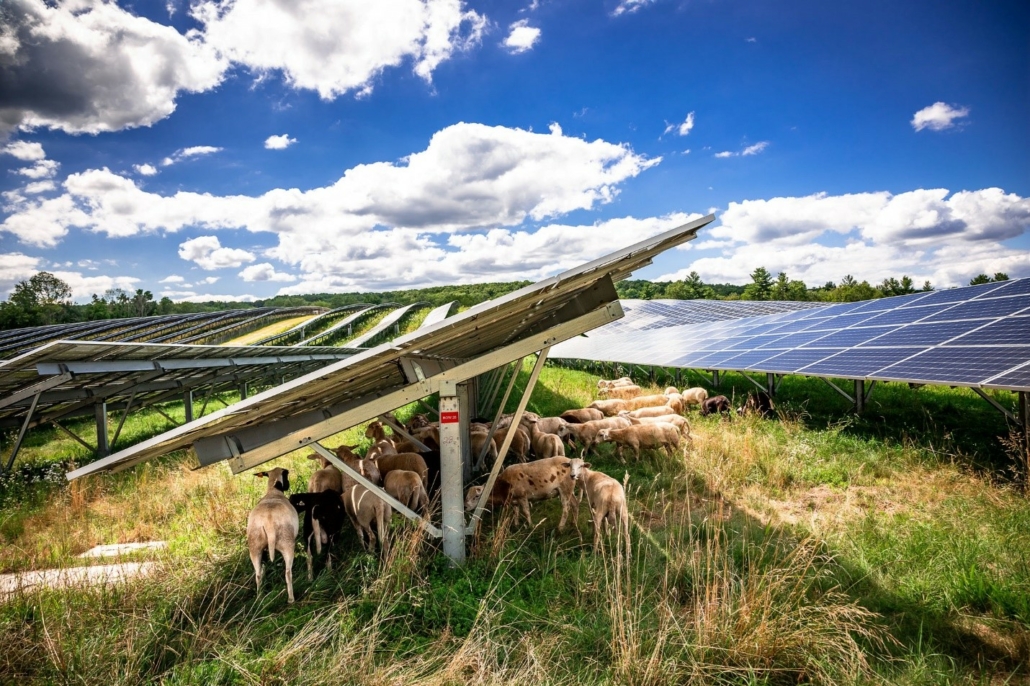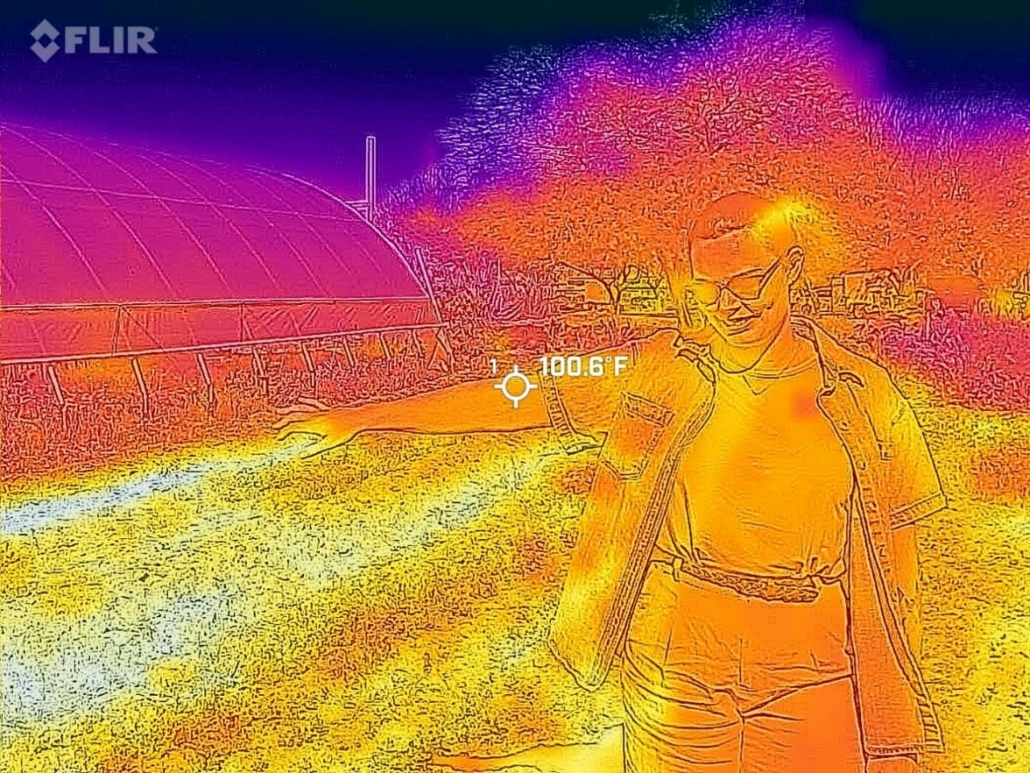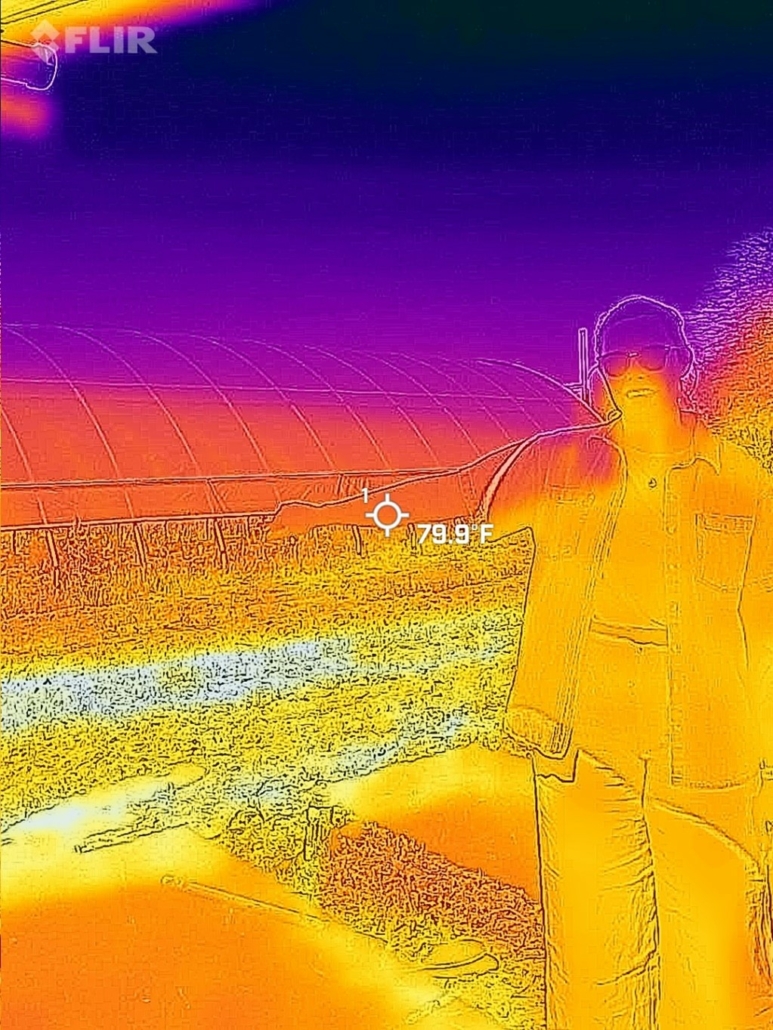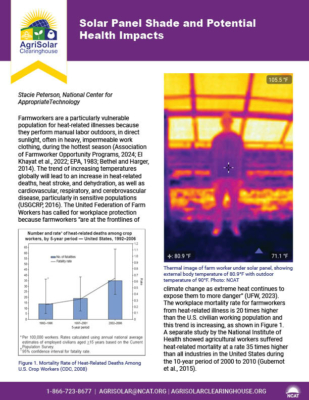Solar Panel Shade and Potential Health Impacts
By Stacie Peterson, National Center for Appropriate Technology
Farmworkers are a particularly vulnerable population for heat-related illnesses because they perform manual labor outdoors, in direct sunlight, often in heavy, impermeable work clothing, during the hottest season (Association of Farmworker Opportunity Programs, 2024; El Khayat et al., 2022; EPA, 1983; Bethel and Harger, 2014). The trend of increasing temperatures globally will lead to an increase in heat-related deaths, heat stroke, and dehydration, as well as cardiovascular, respiratory, and cerebrovascular disease, particularly in sensitive populations (USGCRP, 2016). The United Federation of Farm Workers has called for workplace protection because farmworkers “are at the frontlines of climate change as extreme heat continues to expose them to more danger” (UFW, 2023). The workplace mortality rate for farmworkers from heat-related illness is 20 times higher than the U.S. civilian working population and this trend is increasing, as shown in Figure 1. A separate study by the National Institute of Health showed agricultural workers suffered heat-related mortality at a rate 35 times higher than all industries in the United States during the 10-year period of 2000 to 2010 (Gubernot et al., 2015).

In addition to mortality, many farmworkers experience heat-related illnesses such as heat exhaustion, heat stress, heat stroke, cramps, and rashes (Association of Farmworker Opportunity Programs, 2024). Several strategies can successfully alleviate heat stress and mortality. A consistent recommendation is providing farmworkers with access to shade (OSHA, 2023; EPA, 2023). However, farmworkers do not always have consistent access to shade (El Khayat, 2022). Solar arrays could provide this consistent shade, if designed to accommodate farmworkers, with a panel heigh of 6 to 8 feet. The image below shows the thermal image of a farmworker under a solar panel. The worker’s skin temperature is 80.9°F. The outdoor temperature was approximately 90°F.

Heat stress also affects farm animal health. In a study of the thermal comfort and wellbeing experienced by dairy heifers provided solar panel shade, researchers showed that shade provided by the solar panels efficiently relieved heat load on the cattle, cooled off their body surface and skin temperatures by 10.8°F, and decreased the costs of thermoregulation (Faria et al., 2023). A study of heat stress, solar panels, and dairy cattle in Minnesota found a decrease in heat stress in dairy cattle under solar panel shade, corresponding to a decrease in body temperature (Sharpeet al., 2020).
A separate study on heat stress and sheep with access to solar panel shade found a decrease in wool-surface temperature in ewes ranging from 44.6°F to 46.4°F and a decrease in skin temperature of 33.8°F to 34.7°F (Fonsêca et al., 2023).

Potential Solar Panel Shade Impacts
While touring agrisolar sites, the AgriSolar Clearinghouse team performed skin temperature readings under solar panels and in full sun. Table 1 shows the consistent decrease in skin temperature throughout the country, ranging from 7.8°F to 20.8°F, and the subsequent photos show infrared reading and skin temperature of a farm worker in Phoenix, Arizona.
Table 1. Skin Temperature Readings in Full Sun and Under Solar Panels
| Agrisolar Location | Full Sun Skin Temperature (Fahrenheit) | Solar Shade Skin Temperature (Fahrenheit) | Skin Temperature Decrease (Fahrenheit) |
| Lake Pulaski, Minnesota | 100.5 | 80.6 | 19.9 |
| Monson, Massachusetts | 101.3 | 93.5 | 7.8 |
| Boulder, Colorado | 90.7 | 75.4 | 15.3 |
| Butte, Montana | 101.2 | 81.8 | 19.4 |
| Phoenix, Arizona | 100.6 | 79.8 | 20.8 |
| Champaign, Illinois | 102.5 | 94.1 | 8.4 |


Based on skin temperature tests and animal testing at solar arrays, there is a potential for solar panels to provide shade to farmworkers and help alleviate heat stress. While other farmworker safety measures can and should be incorporated, such as water, rest, and acclimatization, a decrease of 10°F to 20°F could potentially alleviate heat-related illnesses and curb heat-related mortality. Additionally, timing agricultural work to coincide with the full shade of the solar panel and designing panel heights to accommodate farmworkers and animals, meaning a panel height of 6 to 8 feet, would ensure consistent access to the shade and its benefits.
References
Association of Farmworker Opportunity Programs. 2024. Heat Stress Prevention.
Bethel, J., and R. Harger. 2014. Heat-Related Illness among Oregon Farmworkers. (9), 9273-9285. doi:10.3390/ijerph110909273.
Centers for Disease Control (CDC). 2008. Heat-Related Deaths Among Crop Workers—United States, 1992-2006. Jama, 300(9), 1017. doi:10.1001/jama.300.9.1017.
El Khayat M, D.A. Halwani, Hneiny L, Alameddine I, Haidar MA, Habib RR. Impacts of Climate Change and Heat Stress on Farmworkers’ Health: A Scoping Review. 2022. Front Public Health. February 8. 10:782811. doi: 10.3389/fpubh.2022.782811. PMID: 35211437; PMCID: PMC8861180. Doi.org/10.1016/j.applanim.2023.105998
Faria, Ana Flávia, P.A., Alex S.C. Maia, Gustavo A.B. Moura, Vinícius F.C. Fonsêca, Sheila T. Nascimento, Hugo F.M. Milan, and Kifle G. Gebremedhin. 2023. Use of Solar Panels for Shade for Holstein Heifers Animals, No. 3: 329. doi.org/10.3390/ani13030329
Fonsêca, Vinicius de França Carvalho, Eric de Andrade Culhari, Gustavo André Bernado Moura, Sheila Tavares Nascimento, Hugo Maia Milan, Marcos Chiquitelli Neto, and Alex Sandro Campos Maia. 2023. Shade of solar panels relieves heat load of sheep. Applied Animal Behavior Science. Volume 265,105998, ISSN 0168-1591. Doi.org/10.1016/j.applanim.2023.105998
Gubernot, D.M., G.B. Anderson, and K.L. Hunting. Characterizing Occupational Heat-Related Mortality in the United States, 2000-2010: An Analysis Using the Census of Fatal Occupational Injuries database. 2015. Am J Ind Med. February. 58(2):203-11. doi: 10.1002/ajim.22381. PMID: 25603942; PMCID: PMC4657558.
Occupational Safety and Health Administration. 2023. Protecting Workers from the Effects of Heat. DTSEM FS-3743 09/202.
Sharpe, K.T., B.J. Heins, E.S. Buchanan, and M.H. Reese. 2021 Evaluation of solar photovoltaic systems to shade cows in a pasture-based dairy herd. J Dairy Sci. March. 104(3):2794-2806. doi: 10.3168/jds.2020-18821.
United Farm Workers (UFW). 2023. Farm Workers Demand OSHA Issue Federal Heat Rule.
U.S. Environmental Protection Agency (EPA). 2023. Preventing Heat Stress in Agriculture.
U.S. Environmental Protection Agency (EPA). 1983. A Guide to Heat Stress in Agriculture. Occupational Safety and Health Administration.
U.S. Global Change Research Program (USGCRP). 2016. The Impacts of Climate Change on Human Health in the United States: A Scientific Assessment. health2016.globalchange.gov/



